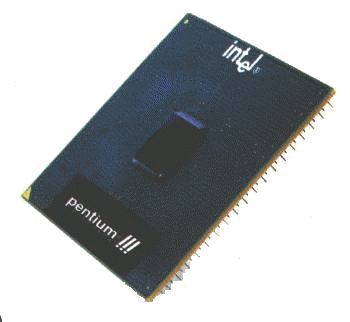






![]()
The Transistor and the Microprocessor
The microprocessor itself is actually just a type of integrated circuit. In November 1971, Intel introduced the world's first commercial microprocessor, the 4004, invented by three Intel engineers. Primitive by today's standards, it contained a mere 2300 transistors and performed about 60,000 calculations in a second. Twenty-five years later, the microprocessor is the most complex mass-produced product ever, with more than 5.5 million transistors, all either acting as amplifiers, oscillators or switches. In addition to the transistors, other components, such as resistors, diodes, capacitors and wires are packed on to the CPU chip.
 The microprocessor's introduction revolutionised the computer industry in the
second half of the 20th century. Previously, computers had been huge machines, filling
multiple rooms. There were other problems too: the impractical vacuum tubes in use in
computers at the time led to constant reliability and heating problems. The invention of
the transistor and subsequent invention of the integrated circuit enabled scientists to
invent the microprocessor, which was to transform computers from massive expensive
contraptions, to the desktop, laptop and palmtop PC's so useful in our lives today.
The microprocessor's introduction revolutionised the computer industry in the
second half of the 20th century. Previously, computers had been huge machines, filling
multiple rooms. There were other problems too: the impractical vacuum tubes in use in
computers at the time led to constant reliability and heating problems. The invention of
the transistor and subsequent invention of the integrated circuit enabled scientists to
invent the microprocessor, which was to transform computers from massive expensive
contraptions, to the desktop, laptop and palmtop PC's so useful in our lives today.
The transistor used most commonly in the microelectronics industry is called a metal-oxide semiconductor field-effect transistor (MOSFET).
Construction of Microprocessors
The Microprocessor is made using techniques which are very similar to those used in manufacturing other integrated circuits. However, because of their extremely complex structure, their manufacture requires extremely precise techniques. In order to make them more economical, microprocessors are mass-produced. Several hundred dies, or circuit patterns, are created on the surface of a silicon wafer simultaneously. Microprocessors are constructed by a process of deposition and removal of conducting, insulating, and semiconducting materials one thin layer at a time until, after hundreds of separate steps, a complex sandwich is constructed that contains all the interconnected circuitry of the microprocessor. Only the outer surface of the silicon, a layer about one-tenth the thickness of a human hair, is used for the electronic circuit. The processing steps include substrate creation, oxidation, lithography, etching, ion implantation, and film deposition.
History
 As mentioned earlier, the first microprocessor was invented in 1971 by three
Intel engineers. The Intel 4004, which was originally developed for use in calculators,
contained about 2300 transistors on a 4-bit microprocessor that could perform only 6000
operations per second. The first 8-bit microprocessor was the Intel 8008, developed in
1972 to run computer terminals. The Intel 8008 contained 3300 transistors. The first truly
general-purpose microprocessor, developed in 1974, was the 8-bit Intel 8080, which
contained 4500 transistors and could execute 200,000 instructions per second. Modern
microprocessors have much greater capacity and speed. Current processors are mostly
32-bit, with 64-bit versions currently being developed. These current microprocessors
include the Intel Pentium III and the AMD Athlon, containing several millions transistors. By the year 2010, microprocessors are expected to
contain as many as 800 million transistors.
As mentioned earlier, the first microprocessor was invented in 1971 by three
Intel engineers. The Intel 4004, which was originally developed for use in calculators,
contained about 2300 transistors on a 4-bit microprocessor that could perform only 6000
operations per second. The first 8-bit microprocessor was the Intel 8008, developed in
1972 to run computer terminals. The Intel 8008 contained 3300 transistors. The first truly
general-purpose microprocessor, developed in 1974, was the 8-bit Intel 8080, which
contained 4500 transistors and could execute 200,000 instructions per second. Modern
microprocessors have much greater capacity and speed. Current processors are mostly
32-bit, with 64-bit versions currently being developed. These current microprocessors
include the Intel Pentium III and the AMD Athlon, containing several millions transistors. By the year 2010, microprocessors are expected to
contain as many as 800 million transistors.